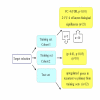An integrative model for recurrence in ovarian cancer
- PMID: 18211683
- PMCID: PMC2248209
- DOI: 10.1186/1476-4598-7-8
An integrative model for recurrence in ovarian cancer
Figures









Similar articles
-
Gene expression profiling of epithelial ovarian tumours correlated with malignant potential.Mol Cancer. 2004 Oct 7;3:27. doi: 10.1186/1476-4598-3-27. Mol Cancer. 2004. PMID: 15471544 Free PMC article.
-
Independent test set performance in the prediction of early relapse in ovarian cancer with gene expression profiles.Clin Cancer Res. 2005 Nov 1;11(21):7958-9; author reply 7959. doi: 10.1158/1078-0432.CCR-05-1216. Clin Cancer Res. 2005. PMID: 16278422 No abstract available.
-
Potential role of miR-9 and miR-223 in recurrent ovarian cancer.Mol Cancer. 2008 Apr 28;7:35. doi: 10.1186/1476-4598-7-35. Mol Cancer. 2008. PMID: 18442408 Free PMC article.
-
Modelling genetic and clinical heterogeneity in epithelial ovarian cancers.Carcinogenesis. 2011 Oct;32(10):1540-9. doi: 10.1093/carcin/bgr140. Epub 2011 Aug 22. Carcinogenesis. 2011. PMID: 21859834
-
Microarray-based gene expression studies in ovarian cancer.Cancer Control. 2011 Jan;18(1):8-15. doi: 10.1177/107327481101800102. Cancer Control. 2011. PMID: 21273975 Review.
Cited by
-
Interleukin-1 Receptor Type 2 Acts with c-Fos to Enhance the Expression of Interleukin-6 and Vascular Endothelial Growth Factor A in Colon Cancer Cells and Induce Angiogenesis.J Biol Chem. 2015 Sep 4;290(36):22212-24. doi: 10.1074/jbc.M115.644823. Epub 2015 Jul 24. J Biol Chem. 2015. PMID: 26209639 Free PMC article.
-
Glomus tumors in neurofibromatosis type 1: genetic, functional, and clinical evidence of a novel association.Cancer Res. 2009 Sep 15;69(18):7393-401. doi: 10.1158/0008-5472.CAN-09-1752. Epub 2009 Sep 8. Cancer Res. 2009. PMID: 19738042 Free PMC article.
-
Targeting AMPK signaling in combating ovarian cancers: opportunities and challenges.Acta Biochim Biophys Sin (Shanghai). 2016 Apr;48(4):301-17. doi: 10.1093/abbs/gmv128. Epub 2016 Jan 12. Acta Biochim Biophys Sin (Shanghai). 2016. PMID: 26764240 Free PMC article. Review.
-
Immune-Related Genes' Prognostic, Therapeutic and Diagnostic Value in Ovarian Cancer Immune-Related Gene Biomarker in Ovarian Cancer.Cancer Control. 2023 Jan-Dec;30:10732748231168756. doi: 10.1177/10732748231168756. Cancer Control. 2023. PMID: 37078136 Free PMC article.
-
Pre-Treatment of platinum resistant ovarian cancer cells with an MMP-9/MMP-2 inhibitor prior to cisplatin enhances cytotoxicity as determined by high content screening.Int J Mol Sci. 2013 Jan 22;14(1):2085-103. doi: 10.3390/ijms14012085. Int J Mol Sci. 2013. PMID: 23340649 Free PMC article.
References
-
- Parkin DM, Bray F, Ferlay J, Pisani P. Global cancer statistics, 2002. CA Cancer J Clin. 2005;55:74–108. - PubMed
-
- The National Cancer Registry Ireland http://www.ncri.ie
-
- DiSaia PJ, Creasman WT, eds . Epithelial ovarian cancer. Clinical gynecologic oncology. St. Louis: Mosby Year Book; 1997. pp. 282–350.
-
- Kikkawa F, Nawa A, Ino K, Shibata K, Kajiyama H, Nomura S. Advances in treatment of epithelial ovarian cancer. Nagoya J Med Sci. 2006;68:19–26. - PubMed
MeSH terms
LinkOut - more resources
Full Text Sources
Medical

